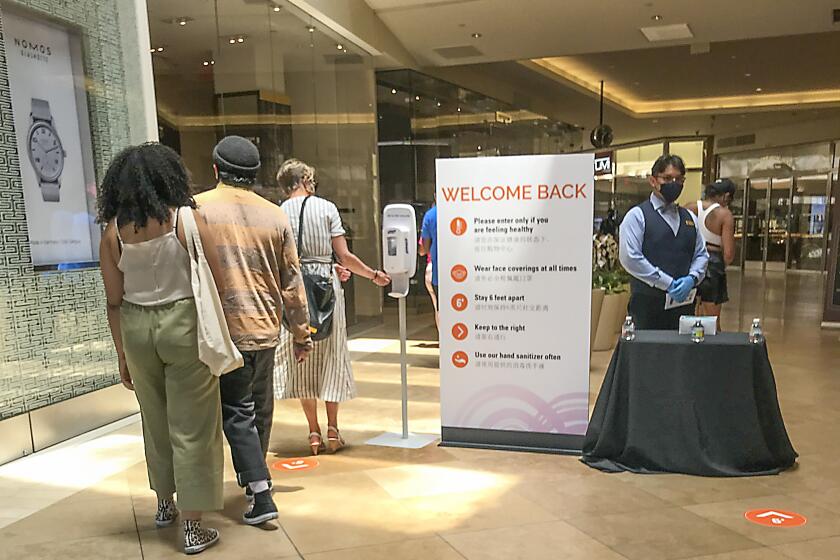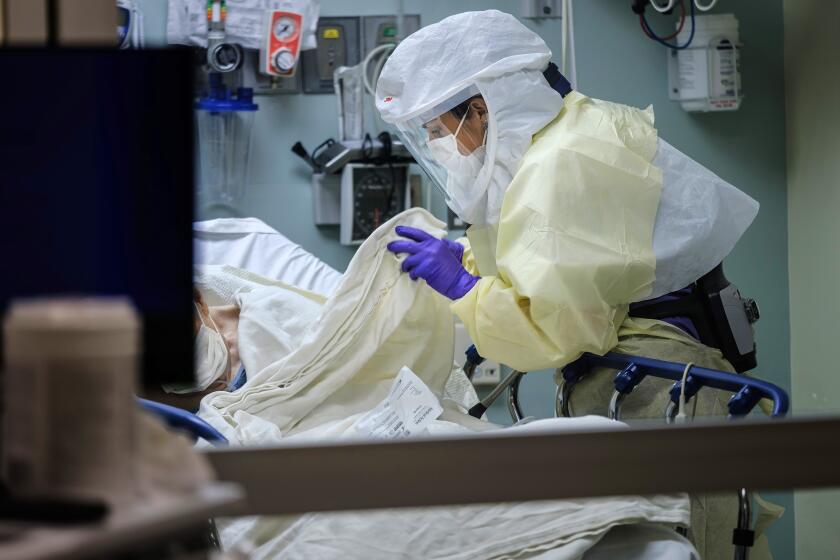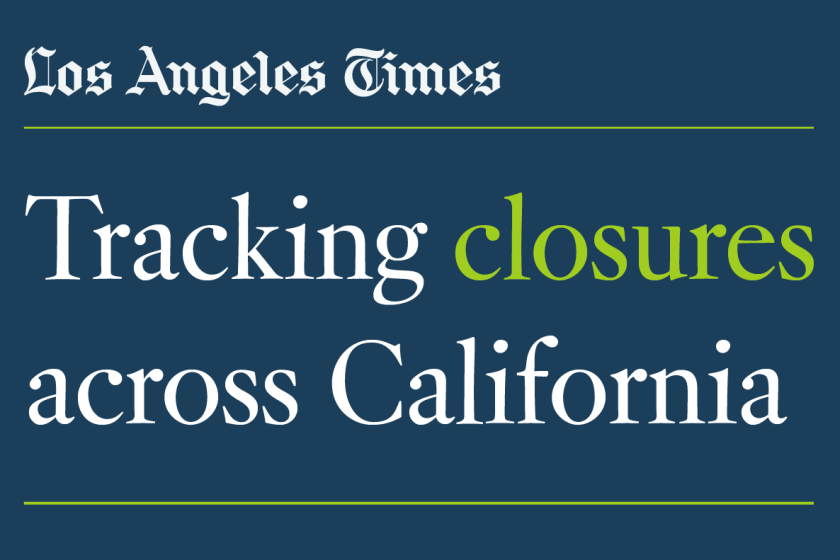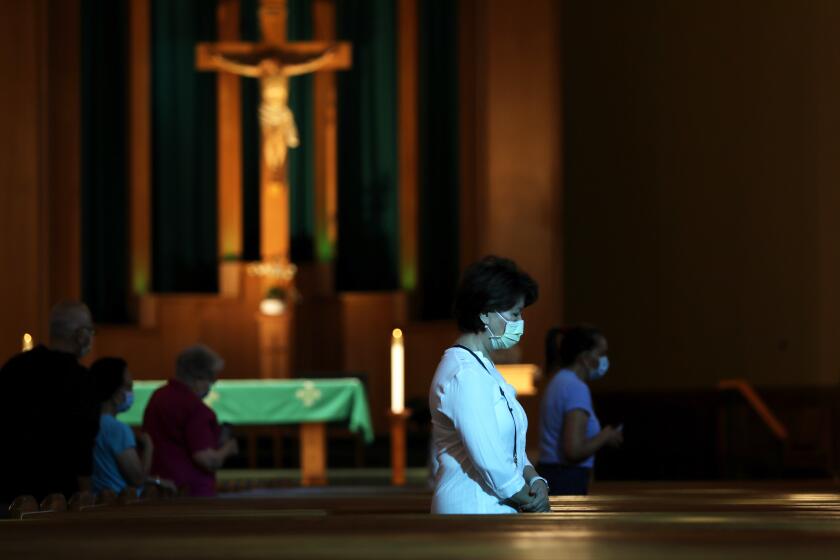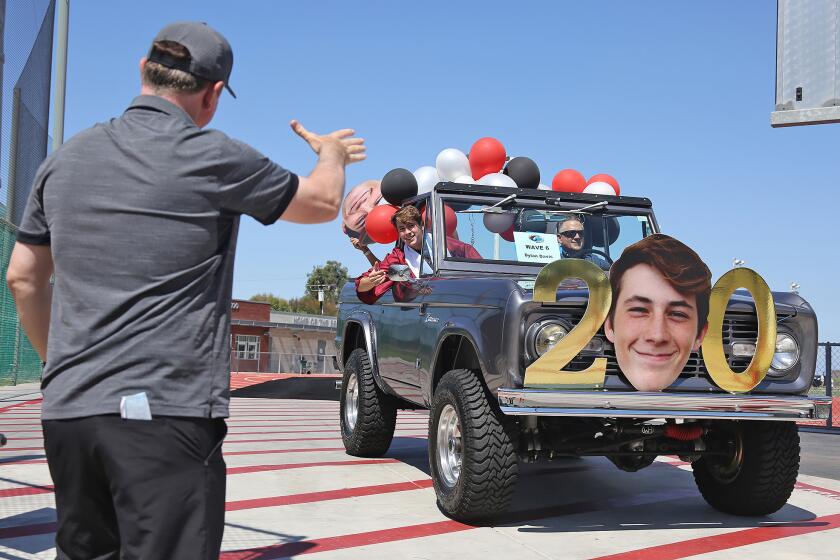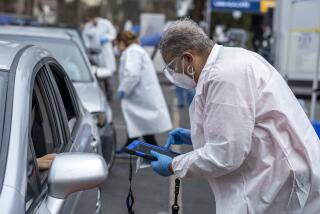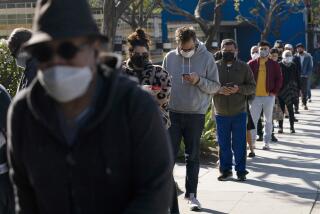How California went from a rapid reopening to a second closing in one month
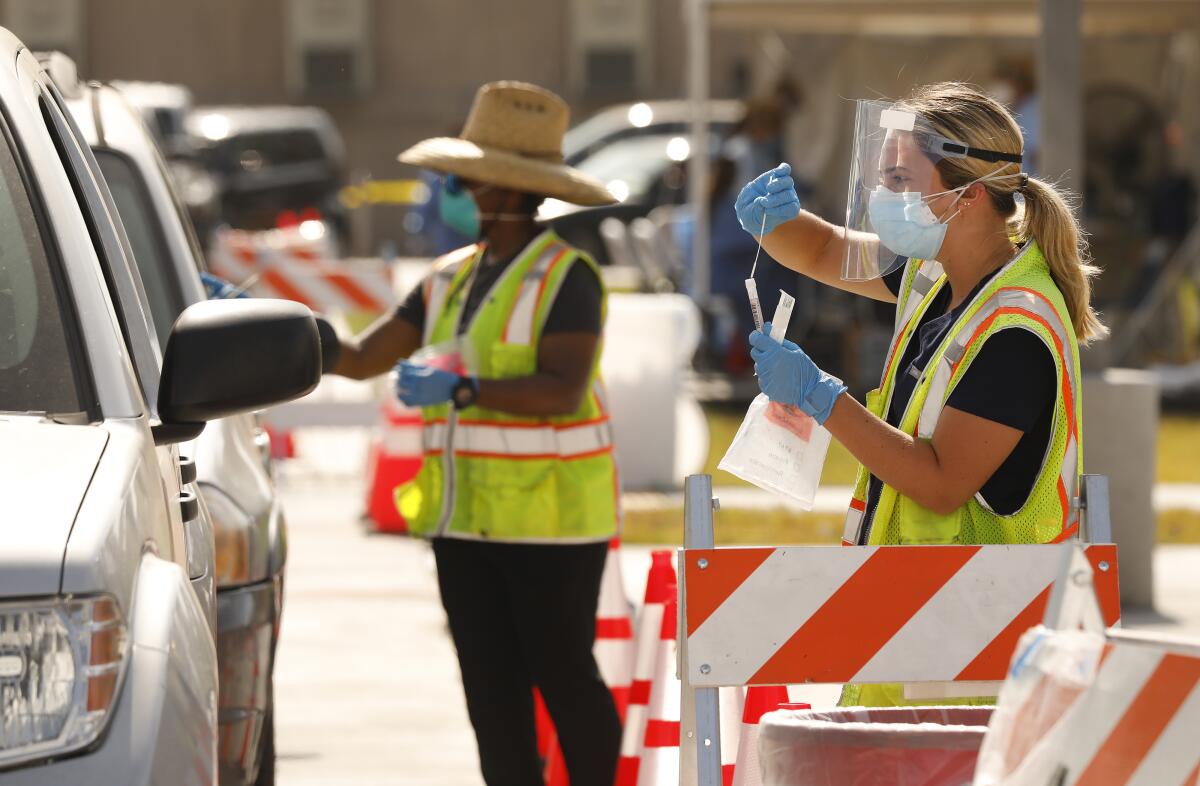
- Share via
Two months ago, California looked like a coronavirus success story.
The first-in-the-nation stay-at-home order helped the state avoid the explosion of cases and deaths that New York and New Jersey had experienced, and officials said it was safe to begin reopening the economy.
But the last six weeks have been a disaster. Coronavirus cases have spiked, along with hospitalizations. In a few counties, hospitals are approaching capacity.
Schools in Los Angeles and San Diego as well as parts of the Bay Area say they won’t open campuses for in-person learning this fall. And many of the businesses that were allowed to reopen in May — shopping malls, indoor dining establishments, bars, movie theaters — are again closed in many areas.
Gov. Gavin Newsom announced new restrictions to halt indoor dining statewide, gyms, churches, hair salons and other businesses in much of the state.
The reversal of fortune has left residents angry and afraid — and wondering whether the conditions will get worse.
“We made so much progress in March and April,” Los Angeles Mayor Eric Garcetti said Monday. “There is no question that the pandemic has gotten worse, here in L.A., across California and across this country. … We did the right thing before. And now we have to do the right thing again.”
Here is rundown of where things stand, from coverage by The Times:
Why did the number of cases go up?
Experts think the stay-at-home order was a big success. But it also devastated the economy.
In May, officials began to rapidly reopen businesses. People had been pent up in their homes and were eager to get back to routines — dining, shopping, Memorial Day barbecues, graduation celebrations, Father’s Day gatherings. Around the same time, historic protests began, triggered by outrage over the death in Minneapolis of George Floyd while in police custody, which sparked demonstrations across the nation, including in the streets of California.
There is no strong evidence that the protests caused a major spread of the coronavirus. But officials think social events, parties and people out in public without masks did cause infections to rise, beginning around Memorial Day weekend.
The Memorial Day weekend appears to have been the turning point that pushed California into the coronavirus surge it’s seeing now.
A Los Angeles Times analysis found that new coronavirus hospitalizations in California began accelerating around June 15 at a rate not seen since early April, immediately after the coronavirus began rapidly spreading throughout the state.
In addition to social gatherings, officials said, they became worried the virus could easily spread in bars and restaurants.
Public health officials said indoor dining and drinking pose a more significant public health risk than other retail activities, even with social distancing. Patrons must take off their masks to eat and drink, they often are engaged in conversation and they breathe in indoor air that may be contaminated by the virus and circulated by air vents — all of which can spread the coronavirus.
When they did allow indoor dine-in service to resume, officials in Los Angeles County found that many were not following safety rules. On June 27 and 28, 49% of bars and 33% of restaurants were not adhering to physical distancing protocols indoors, while 54% of bars and 44% of restaurants were not enforcing mask and face shield requirements, health officials found.
Officials began rolling back reopenings just before the July 4 weekend. It likely will be apparent in a few weeks whether the new closures will have done anything to help slow the spread of the virus.
What do we know about the new closures?
Most Californians were already seeing new restrictions this month. But Monday, Gov. Gavin Newsom ordered a halt to all indoor dining and closed bars, zoos and museums.
At the same time, most counties — including Los Angeles, San Bernardino, Orange and Riverside — will be forced to shutter gyms, houses of worship, hair salons, malls and other businesses under the new order, which remains in effect indefinitely. In addition, offices with nonessential workers in those counties must close.
The move further pushes Californians back into their homes during a time when they are typically enjoying summer vacations. The stricter measures to close gyms, churches and other services affect 29 counties that are among the most populous in the state, where 80% of California residents live.
Here are the details:
Statewide action closures
- Dine-in restaurants
- Wineries and tasting rooms
- Movie theaters
- Family entertainment centers (for example: bowling alleys, miniature golf, batting cages and arcades)
- Zoos and museums
- Card rooms
- Bars, brewpubs, breweries and pubs across the state must close all operations, both indoor and outdoor
Localized action
Counties that have remained on the state’s watch list County Monitoring List for three consecutive days, including all Southern California counties and many in the Central Valley, must close the following businesses:
- Gyms and fitness centers
- Places of worship
- Indoor protests
- Offices for nonessential sectors
- Personal care services, such as nail salons, body waxing and tattoo parlors
- Hair salons and barbershops
- Indoor shopping malls
To contain the spread of COVID-19, parks, restaurants and stores are slowly reopening.
Why was the action taken?
“We’re seeing an increase in the spread of the virus, so that’s why it’s incumbent upon all of us to recognize soberly that COVID-19 is not going away any time soon until there is a vaccine or an effective therapy,” Newsom said Monday.
As of Monday, California had seen more than 333,000 confirmed cases and more than 7,000 related deaths, according to the Los Angeles Times’ tracker.
California averaged 8,211 new cases a day during the past week. The previous week, the average was 7,876.
Newsom has routinely highlighted the growing number of infections, even as the state was moving forward with reopening, including giving the green light to nail salons, tattoo parlors and massage therapy facilities, which are some of the highest-risk sectors for transmissions. Last month, Newsom issued orders requiring all Californians to wear masks or other face coverings while in public or in high-risk settings.
Mask-wearing in public has become an increasingly pressing and politicized issue as the economy reopens and cases surge across the nation.
Almost 1,000 of San Francisco’s roughly 4,600 cases have been diagnosed in the last two weeks, said Dr. Grant Colfax, the city’s director of public health.
In San Francisco, nearly half of all those who have tested positive in the city are Latinos, he said, even though Latino residents make up just 15% of the city’s population. Overall, the city has seen 7.8 new infections per 100,000 residents over the last seven days, far above its goal of no more than 1.8 new infections per 100,000 people.
“This, again, indicates that the virus is spreading throughout the city, particularly ... in the southeast part of the city,” Colfax said.
For every one person who contracts the virus, 1.25 people on average are now infected, he said. “We really need to drive that down to 1 or below as quickly and as soon as possible.”
The transmission rate also rose above 1 in L.A. County in June, but has since fallen back to 1. “The virus currently rages on in our community,” Public Health Director Barbara Ferrer said.
What about schools?
In California, day by day, more school systems are choosing to keep campuses closed and offer online learning only.
At the Los Angeles Unified School District, the nation’s second-largest school system will continue with online learning until further notice, Supt. Austin Beutner announced Monday.
The difficult decision became unavoidable in recent weeks, Beutner said, as coronavirus cases have skyrocketed in Los Angeles County, and the district cannot come close to protecting the health and safety of some half a million K-12 students and about 75,000 employees.
The superintendent also pointedly called for county, state and federal officials to provide leadership and funding for regular coronavirus testing and contact tracing. He said that school districts also needed clearer guidance on when and how to reopen. Beutner estimated it would cost $300 a year per person to test all students and staff members once a week.
Other school districts — including San Diego and some in the Bay Area — are following suit.
San Diego Unified’s teachers union said Monday it agrees with the district’s decision to delay in-person reopening.
Kisha Borden, president of the union, noted that some classrooms have windows that don’t open. There is a growing consensus among experts that ventilation is crucial to prevent spread of the virus indoors.
“We don’t feel it’s safe to bring 120,000 kids into enclosed spaces, into classrooms at this time, especially if we can’t guarantee social distancing, if we don’t have adequate ventilation in those classrooms,” Borden said.
The Orange County Board of Education voted 4-1 to reopen school campuses but is leaving the decision up to individual school districts.
Meanwhile Orange County education leaders voted 4 to 1 Monday evening to approve recommendations for reopening schools in the fall that do not include the mandatory use of masks for students or increased social distancing in classrooms amid a surge in coronavirus cases.
The Board of Education did, however, leave reopening plans up to individual school districts.
Among the recommendations are daily temperature checks, frequent handwashing and use of hand sanitizer, in addition to the nightly disinfection of classrooms, offices and transportation vehicles.
The recommendations, contained in a white paper, widely support schools reopening in the fall. The document states that remote learning amid the COVID-19 pandemic has been an “utter failure” and suggests allowing parents to send their children to another district or charter school to receive instruction if their home district does not reopen campuses.
Times Community News reporter Sara Cardine contributed to this report.
More to Read
Sign up for Essential California
The most important California stories and recommendations in your inbox every morning.
You may occasionally receive promotional content from the Los Angeles Times.
